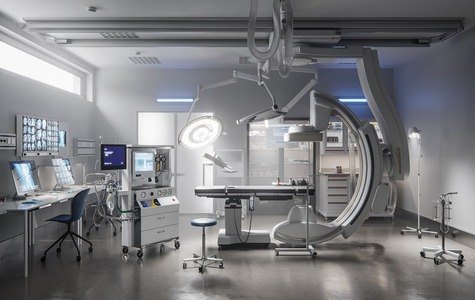- Medical Devices
- Wednesday, 12 Apr 2023
Surgical Robots for the Spine Market (2022-2028) Business Outlook and Global Market Assessment
Surgical Robots for the Spine Market: Key Insights
The surgical robots for the spine market is poised for growth, with an increasing demand for minimally invasive surgeries and the integration of robotics technology in the healthcare sector. Surgical robots in spinal surgeries offer several advantages, such as improved precision, reduced blood loss, and quicker recovery time for patients. This has led to the increasing adoption of surgical robots in spinal surgeries.
Opportunities in the surgical robots for the spine market include the development of new and advanced surgical robots that cater to the specific needs of spinal surgeries and the increasing prevalence of spinal disorders such as herniated discs and spinal stenosis. Additionally, the aging population and a growing burden of spinal disorders are driving the demand for surgical robots in spinal surgeries. However, the high cost of surgical robots and the dearth of skilled professionals to operate these robots are significant restraints in the growth of surgical robots for the spine market. In addition, the lengthy approval process for new surgical robots and the need for reimbursement for robot-assisted surgeries in some countries pose challenges to the growth of the spine market.
Rising Adoption of Minimally Invasive Surgeries and Growing R & D Investments by Advanced Drug System is Driving the Surgical Robots for the Spine Market
The increasing usage of image-guided robots coupled with fluoroscopy techniques is a significant factor driving the surgical robots for the spine market. Fluoroscopy is a real-time imaging technique that helps in guiding surgical robots during procedures. Image-guided robots provide real-time imaging information to the surgeon, making it easier to navigate complex spinal anatomy and perform precise procedures.
Using image-guided robots and fluoroscopy techniques in spinal surgeries offers several benefits over traditional surgical methods. These benefits include improved accuracy, reduced blood loss, and quicker recovery times for patients. The improved accuracy of image-guided robots in spinal surgeries can result in fewer complications and better patient outcomes. The combination of image-guided robots and fluoroscopy techniques enables surgeons to perform minimally invasive procedures, reducing the need for large incisions and minimizing the risk of tissue damage. This, in turn, reduces the recovery time for patients and helps them return to their normal activities faster.
Surgical Robots for the Spine Market: Segmental Overview
The global Surgical Robots for the Spine market is segmented on the basis of surgical type, surgical approach, condition, applications, and end user. Based on surgical type, the global surgical robots for the spine market is segmented into open surgery and minimal invasive surgery. On the basis of surgical approach, the market is segmented into anterior approach, posterior approach, and lateral approach. Based on condition, the market is bifurcated into degenerative disc disease, disc herniation, fractures, instability, deformity, tumors, and infections. Based on applications, the global surgical robots for the spine market is segmented into laminectomy,spinal fusion,artificial disc replacement, anterior cervical discectomy, forminatomy, interlaminar implant, epidural lysis of adhesions, percutaneous vetrebroplasty, chronic back pain, laminotomy, ollif, spinal stenosis. On the basis of end users, the market is segmented into hospitals and clinics, spine surgery centers, and neurosurgery centers.
The minimal invasive surgery segment is expected to hold a significant share of the global surgical robots for the spine market. Minimally invasive surgery, or laparoscopic surgery, is a surgical technique that involves making small incisions and using specialized instruments and cameras to perform the procedure. Minimal invasive surgery has several advantages over traditional open surgery, including reduced blood loss, fewer complications, quicker recovery times, and smaller scars. These benefits have led to an increasing demand for minimally invasive surgeries, including spinal surgeries. The use of surgical robots in minimally invasive spinal surgeries offers several advantages, including improved precision and reduced tissue damage. The improved accuracy and precision of surgical robots can result in better outcomes for patients and reduce the risk of complications.
Surgical Robots for the Spine Market: Competitive Landscape and Key Developments
Johnson & Johnson (DePuy Synthes); Zimmer Biomet (Medtech SA); Smith & Nephew; Intuitive Surgical; Stryker; NuVasive, Inc; Hansen Technologies; Accuray Incorporated; Renishaw plc, and Medtronic (Mazor Robotics) are among the key players operating in the surgical robots for the spine market. These companies have a widespread presence worldwide, which provides lucrative opportunities to serve a large number of customers and expand the surgical robots for the spine market.
Contact Us
Contact Us: The Insight Partners
Phone: +1-646-491-9876
Email Id: sales@theinsightpartners.com
Related Industry Updates
Spinal Implants Market Business Opportunity 2021 – Top Companies : Fitbit Inc.,Apple Inc.,Xiaomi Technology Co. Ltd.,Sony Corp.,Samsung Electronics Co. Ltd & More
May 12, 2021
Asia Pacific Infusion Pumps Market is expected to reach US$ 3,114.7Million by 2027 with CAGR of 7.0%.
Sep 16, 2020
Colorectal Cancer Treatment Market is expected to reach US$ 23.978 billion by 2030
Feb 08, 2024
Europe Kidney Stones Retrieval Devices Market Future to See an Outstanding Revenue US$ 1,020.5million in 2027 with CAGR of 4.5% | Business Market Insights
Jan 25, 2021
Global Bioprocess Containers Market Share, Size, Trends, Top Players and Forecast by 2026 | Thermo Fisher Scientific Inc., Lonza, PARKER HANNIFIN CORP, Merck KGaA, Sartorius AG
Mar 17, 2021
Clinical Trial Imaging Market Booming 2027 in Worldwide with Bioclinica, PAREXEL International Corporation, ICON plc, IXICO plc, Intrinsic Imaging, LLC, ERT Clinical, BioTelemetry, Inc., Cardiovascular Imaging Technologies, Medical Metrics
May 05, 2021
NORTH AMERICA Pain Management Devices Market 2020 Regional Outlook 2027 Covid-19 Overview On Top Companies – Pfizer Inc,Abbott,Boston Scientific Corporation,Medtronic,BD
Sep 07, 2020
